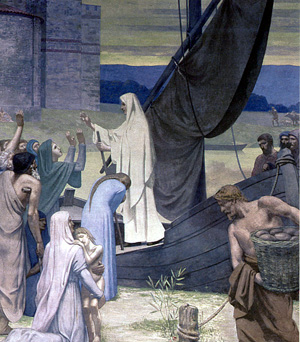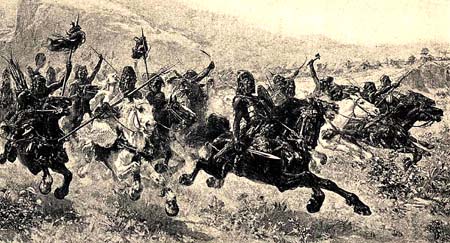 |
The Saint of the Day
St. Genevieve, January 3
Prof. Plinio Corrêa de Oliveira
Biographical selection:
St. Genevieve (422-512), who became the patron saint of Paris, was famous throughout the world even in her own lifetime. In the East as well as West, her name and virtues were known and praised. From the top of his column in Asia Minor, St. Simeon Stylites greeted his sister in Christ and praised her perfection in the Christian virtues. The capital of France was entrusted to her. She was a simple shepherdess, but she protected the destiny of Paris, just as it was a poor and simple farmer, St. Isidore, who watched over the capital of the Spanish people.
How Our Lord chose her as His spouse while she was still a young girl in Nanterre is recounted by St. Germain of Auxerre, one of the greatest Bishops of Gaul in the 5th century. Pope St. Boniface had sent St. Germain to Great Britain to combat the Pelagian heresy around the year 430. He was accompanied by St. Lupus, Bishop of Troyes. On their way through France, they stopped at the village of Nanterre.

St. Genevieve, began her apostolate with the women outside the gates of Paris |
Upon their arrival, the two Prelates went to the Church to pray for the success of their trip. The people surrounded them with pious curiosity and to ask their blessing. Illuminated by a divine inspiration, Germain espied in the crowd a young girl of seven years of age, and he was interiorly advised that Our Lord had chosen her for a singular mission. He asked the name of the child and that she be brought before him. The people told him that her name was Genevieve. Her father and her mother brought her forward.
“Is this child yours?” Germain asked.
They answered, “Yes.”
And the holy man said: “Blessed are you that God hath given you this child. Know you for certain that on the day of her birth the Angels sang and a great feast was made in Heaven. This girl shall be of great merit before the Lord. And from her good life and words many shall take example, that they shall leave the yoke of sin and convert to God.”
Then, he turned toward the child, and she said to him: “Blessed Father, your servant is listening.”
The Bishop asked: “Tell me, and be not embarrassed, if you will consecrate yourself to Christ in purity without stain as His spouse?”
The maid answered: “Blessed be you, my Father. What you ask of me is the most cherished desire of my heart. I ask only that by your prayers, Our Lord will accomplish my desire.”
“Have confidence, my daughter,” said Germain. “Be firm in your resolution. Prove by your works the good things that you believe in your heart and say with your mouth, and Our Lord shall give you strength as well as virtue.”
Comments of Prof. Plinio:
After this prophecy, the child grew in holiness and became the great St. Genevieve, who saved Paris from the attack of Attila and his horde of barbarians in 457. As the Huns approached Paris, Genevieve told the people not to flee the city but to stay. Through the intercession of her prayers, Attila, contrary to what was expected and for no known reason, changed his path of destruction and left Paris untouched. She was truly one of the greatest figures in the History of that time.
In this episode we see the great blossoming of holy souls that would form the foundation for the Middle Ages. Observe the figures of this story. First, there was Pope St. Boniface. He sent St. Germain of Auxerre to England to defend it against the Pelagians. St. Germain was accompanied by another saint, St. Lupus, Bishop of Troyes. That is to say, here alone we have two Bishops - two saints - who were sent by a Pope who was a saint to defend a country that was in danger of being taken by heresy. We can understand the ambience of the sanctity, the intensity of the spiritual life that was the foundation for the Middle Ages.
On their way through France, the two holy Bishops passed through the small village of Nanterre. What was the first thing they did upon arriving? They did not stop at a hotel or inn to rest and take something to eat. Their first concern after a tiring journey was to go to the Church and pray.
Their bearing and sanctity were such that when they entered the Church, the people surrounded them to observe them praying and ask their blessing. We can imagine the little people, the faithful of the village, surrounding the Bishops who were absorbed in prayer before the Blessed Sacrament. We can consider how few occasions today we have to see two holy Bishops praying like this in a chapel to the Blessed Sacrament.

In the 5th century Attila & his hordes rode over Western Europe. The prayers of St. Genevieve diverted him from destroying Paris
|
Then, suddenly, in this ambience of ardent devotion, one of these Bishops received a visible grace from Heaven. By visible, I do not mean something visible to the eye, but visible because it showed him amidst the crowd a child who would be a great saint. It was a girl of seven years of age. He called her to him, and before the astonished and admiring people, the Bishop made a prophecy about the future of this young child. He began with these words: “Know that certainly on the day of her birth the Angels sang and a great feast was made in Heaven.”
We can easily imagine the marvel and admiration of all the villagers. It is not difficult to visualize that for the small village, this was important news. The arrival of the Bishops was already an enormous thing for them. Suddenly the Bishops singled out a girl whom they were accustomed to see playing in the street, barefoot, running here and there. Now they are informed there was a great joy in Heaven when this girl was born. No one doubted. No one asked for evidence and proof. Everyone believed. Why? Because they belonged to this group of blessed souls who believe without having seen.
Everyone believed. The girl also believed, along with her parents. It was so natural that there should be joy in Heaven because a girl who would be holy had been born! The saints were so frequent, so numerous, in that time! They had such a close and continuous contact with Heaven that the people were accustomed to this supernatural communication.
How different this from our days, when a great distance separates contemporary man from the supernatural. Miles and miles separate him from Heaven. Today he does not like to admit that a thing can come from Heaven. He has armed himself with every weapon imaginable to try to deny the supernatural. And if hecomes face-to-face with something undoubtedly supernatural, then and only then does contemporary man resign himself without enthusiasm to admit that something can come from Heaven.
On the contrary, in that time St. Germain immediately realized the future of the girl. He called her to him and asked her if she wanted to consecrate herself to Our Lord. She answered, “My father, this is the most cherished desire of my heart.” And that was that.
Later, she left for Paris. And what remained in Nanterre? She left a wake of light in that village, which took its place in History. Nanterre was born to History because a great supernatural event took place there, where God manifested His plan for St. Genevieve through the words of St. Germain.
We can imagine what happened after the visit of St. Germain. The girl grew in years and holiness. She rose up like a cedar of Lebanon and scented the panorama with her presence. She bloomed like a flower in the center of the West. There was no press, no radio, no television – o what happiness! Nonetheless her fame flew. Even if the people of that time traveled mostly by foot, they had a communication that today we cannot imagine.
Let me give you one small proof of this. Today one of the largest collections of Byzantine coins can be found in the museums of Norway and Sweden. Why? Because the barbarians who lived there in the Middle Ages traveled by foot, crossing Russia, to sell their furs and different pieces in Constantinople. They used to return with Byzantine coins. Since they did not have banks, it was their habit to bury these coins in the ground in secret places. After many centuries of wars, migrations, etc., a great number of those coins still remained in the ground, which is why many have been found in that area. In Byzantium, they no longer have many coins as they were lost in the Islamic invasions, but some of the best collections are preserved in museums of Norway and Sweden.
You can see that these people used to travel and communicate a great deal. So it was that in the East, the other pole of the Christian world, St. Simeon Stylites in Asia Minor had heard about St. Genevieve. He was the famous saint who lived on the top of a column and never stepped off it. He prayed continuously, a kind of hermit. He heard about the virtues of St. Genevieve, and by this kind of radar that the saints have to recognize each other, he knew that she was his spiritual sister and greeted her from afar on the top of his column. We can imagine the supernatural contact of these two saints forming a like of voltaic arch over the oceans, islands, mountains,
deserts, and cities.
Then we can see how fortunate it was to live in those days among so many saints who transmitted the supernatural presence of Heaven, and how sad it is to live in our days, when sanctity is so difficult to find.


  |
| Prof. Plinio Corrêa de Oliveira |
|
The Saint of the Day features highlights from the lives of saints based on comments made by the late Prof. Plinio Corrêa de Oliveira. Following the example of St. John Bosco who used to make similar talks for the boys of his College, each evening it was Prof. Plinio’s custom to make a short commentary on the lives of the next day’s saint in a meeting for youth in order to encourage them in the practice of virtue and love for the Catholic Church. TIA thought that its readers could profit from these valuable commentaries.
The texts of both the biographical data and the comments come from personal notes taken by Atila S. Guimarães from 1964 to 1995. Given the fact that the source is a personal notebook, it is possible that at times the biographic notes transcribed here will not rigorously follow the original text read by Prof. Plinio. The commentaries have also been adapted and translated for TIA’s site.
|
Saint of the Day | Home | Books | CDs | Search | Contact Us | Donate

© 2002- Tradition in Action, Inc. All Rights Reserved
|
 |
|